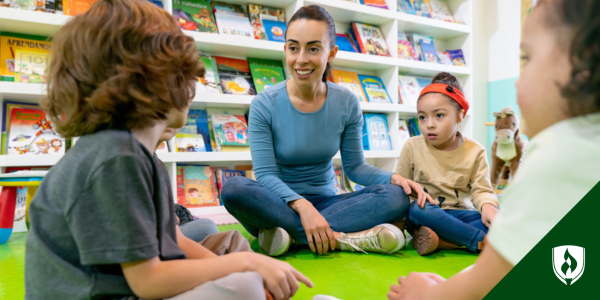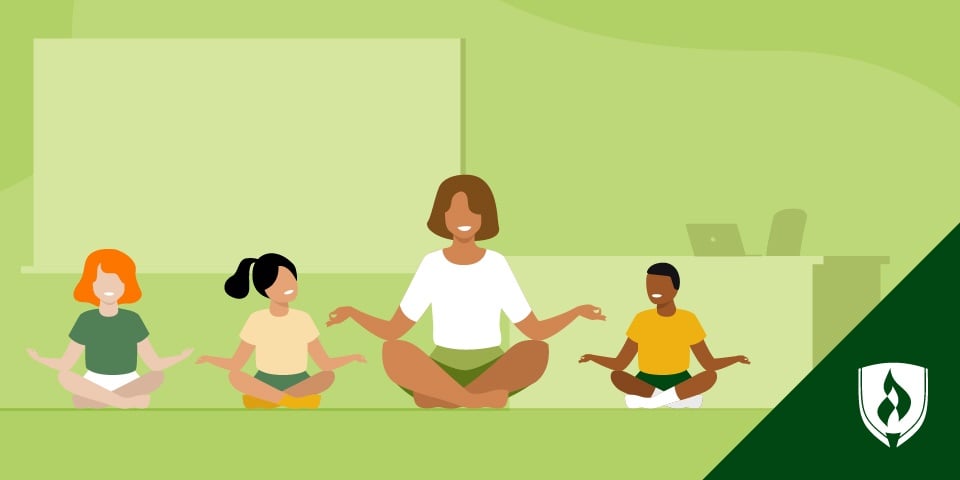
Looking into school options can feel like trying to sort threads in a tapestry. Everything is woven together and jumbled around in ways that takes a lot of research to parse. Terms like montessori, magnet or parochial might send you on a tangent search just to get some definitions. There are difficult decisions to make when finding the right school without the added confusion of different types of schools. That is why we compiled some of the research for you.
Almost every type of school can be sorted into the public or private category based on its funding. Public schools receive their funding from the government and private schools receive funding anywhere else. While most schools can fall into these two categories, the standard public vs. private school breakdown scarcely touches the wide array of schools you can find.
With that in mind, we’ve sorted 13 different types of schools by their primary source of funding. Read on for a guide to school choices in the U.S. and narrow your search for the perfect school.
Read through them all to compare or click on the link below to head straight to the type of school you’re seeking.
Types of Public School
1. Traditional public school
“Public Schools are operated by local, state, and federal government funds,” says Emily Brown of Get Academic Help. The proportions and sources of funding can vary from state to state, according to the National School Boards Association, but only up to 9 percent of traditional public education funding comes from the federal government.
Traditional public schools need to abide by certain standards. Teachers must have the appropriate licensure to work at a public school, which is usually mandated by state in which they are located. Students attend a public school based on where they live and aren’t required to pay tuition. The schools themselves must adhere to rules of curriculum, policy and governance, most of which is decided at the state and local level according to the U.S. Department of Education. A comparison of public school performance and standards by state can be found here.
2. Charter school
“Charter schools offer an institutional hybrid,” writes Great Schools.org. “Like traditional public schools, charter schools are free... . However, parents must usually submit a separate application to enroll a child in a charter school, and like private schools, spaces are often limited.”
Any company, organization or individual can apply for a charter to open a charter school. If the state grants their charter, the school will receive a certain amount of funding for a limited period of time — typically 3-5 years. If the school fails to meet performance expectations, their charter is not renewed, and it closes.
“Chartering allows the school to run autonomously of the existing public school system,” says the Public School Review. “Many offer a unique learning environment, such as a school whose science classes are conducted in the field, or a specialization in arts education.” Charter schools often choose a specialization or mission statement that meets a need of their community.
Teachers and administrators at charter schools have more authority to make decisions than most traditional public schools, and the cost of that freedom is a constant pressure to perform. A new charter school could fail to impress the legislature in its first few years and lose funding. On the bright side, this means a charter school that has been around for a while has proven its worth in achievement several times over.
3. Magnet school
Magnet schools specialize in certain areas such as technology, science or the arts. They are free public schools operated by school districts or a group of districts.
Magnet Education reports that some magnet schools admit students based on achievement, often called “talented & gifted” schools. “They are highly competitive and highly selective,” Brown says, adding that students typically go through rigorous testing and applications to attend. Other magnet schools enroll using a random lottery and will admit any student who desires to attend.
Magnet schools tend to be very intentional about maintaining a diverse student population and are likely to have a waitlist of students trying to enroll. “As a result, they promote higher level cognitive and social learning,” Magnet Education writes. “Magnet schools make the extra effort to create a sense of classroom and school community ... curriculum is also clear and transparent for families so they can more fully engage in the learning of their students.”
4. Public virtual (or online) school
Many public school districts are creating more options for their students by opening virtual options. This can be confusing since there are also virtual private schools, online classes that can supplement a traditional brick-and-mortar education, and virtual classes connected to homeschooling.
A virtual public school, however, has the same teacher credential requirements, academic assessments and management as a traditional public school. K12writes, “Not all virtual programs are alike; it's important to know the difference between high-quality, full time, statewide public virtual schools and other programs that offer simple correspondence or supplemental courses.”
“We are truly meeting our students where they need their teachers to be in their educational journey,” says Elise Harris, a middle school teacher for Florida Virtual School. Harris says a huge benefit of virtual school is the increased flexibility and independence it offers. “Parents and students love the freedom of choice and customization, as well as freedom of scheduling.”
Harris says her virtual school utilizes survey data to offer courses students are looking for and to customize learning plans for each student. “Virtual Teachers can truly individualize learning based on each student's distinctive needs. Because the students have access to courses 24/7 year round, we aren't prisoners of time.”
Since communication is such a crucial pillar of a virtual school’s success, Harris believes parents have the chance to feel more involved in their children’s education. “Students and parents are able to reach out with any questions during the week, knowing they will have their question answered within 24 hours.”
Types of Private School
5. Traditional private school
“Private schools are not funded by the government,” Brown says. “That’s why they charge fees to attend.” This separation from government funding gives them the freedom not to follow the national curriculum according to Brown. A private school without any other special designation may be categorized as independent. After that, the options are endless.
“Private schools may be (run by) for-profit businesses, or they may be nonprofit such as those run by private foundations or religious denominations,” Brown says. In most of these cases, the primary funding for the school comes from its students. Parents pay tuition for their children to attend.
6. Boarding school
“A boarding school by definition is any school that offers food and lodging to its students. However, it’s also much more than that,” writes The Best Schools.org. “A boarding school is a thriving community of scholars, athletes and artists.” To create this community, most boarding schools require most of their students to live on campus for the school year.
Intended to go beyond academia alone, these communities offer opportunities for deeper relationships with faculty and fellow students through all manner of extra-curricular activities all in one place. Faculty, staff, and their families often live on campus and serve in coaching or advising capacities.
7. Language immersion school
Language immersion schools immerse their students in a second language. Bilingual teachers teach their classes in the second language to varying degrees. “In general, the programs are designed for students whose native language is English,” according to the Center for Applied Linguistics (CAL). The CAL lists immersion schools under three main categories: total, partial and two-way immersion.
Total Immersion is where all (or almost all) subjects in the lower grades are taught in the foreign language with English instruction in the older grades. Partial Immersion is where up to 50 percent of subjects are taught in the foreign language. “In some programs, the material taught in the foreign language is reinforced in English,” according to the CAL. Two-way immersion programs give equal emphasis to English and a non-English language because many of their students are native speakers of the non-English language.
While many love the idea of their children developing fluency in another language, they might worry that English scores will take a hit. But Asia Society cites research that shows immersion students scoring just as well, if not better, on standardized English tests than their non-immersed peers by the time they hit high school.
“Moreover, academic achievement on tests administered in English occurs regardless of the second language being learned,” writes the Asia Society. In other words, if the immersion language is alphabet-based (Spanish, Hawaiian, French) or character-based (Mandarin, Japanese, Cantonese), English-proficient students keep pace academically with peers in traditional school.
8. Montessori school
“Montessori is a way of teaching that honors each child’s individuality and interests,” says Shara Challa Arora, executive director of Sugar Mill Montessori and Meadow Montessori schools. “The teacher prepares the classroom, inviting children to explore and learn through hands-on activities.”
Montessori schools put a great emphasis on exploration. Arora says children are encouraged to question and experience the joy of discovering the world around them through their classroom experience. “The curriculum is very well-rounded,” Arora says, explaining that it covers math, language and science as well as sensory-based subjects.
“The classroom communities in a Montessori school are designed to be three year communities,” says Pines Montessori head of school, Patty Sobelman. Each teacher will have the same group of children for three years. Sobelman emphasizes that this structure gives teachers time to build relationships with students and their families that personalize and deepen the studied material. “We enroll families, not just children. When a family chooses Montessori for their child, they choose it for their family as well.”
9. Private special education school
“Private special education schools are focused on students with special needs,” says
Bon Crowder of Math Four. “Often they support specific learning differences like autism spectrum, brain injury, slower processing speeds, ADHD, severe anxiety or other neurological differences.”
These schools will be better equipped than the average school to meet specialized learning needs for their students. Teachers, administration and additional staff like counselors, nurses and academic advisors are highly informed and tuned into the specific needs of their population. This can be a lifesaver for students who need more accommodation than the typical school system offers.
Crowder points out that special education schools focused in one area (like autism) can definitely provide better service to their students, but also that growing students might develop important adaptation and social skills when in school with a less-focused population.
10. Parochial school
A parochial school is a religious private school that receives funding from a local church. While other types of religious school might have varying degrees of funding from a church, the term parochial indicates that the school will be partnered with a local church.
Deacon Michael S. Brooks, principal of St. Patrick School writes on the school website, “A Catholic private school is financed almost completely by the tuition that is paid for each student in attendance. If the expenses for running the school go up significantly, the tuition goes up accordingly. A Catholic parochial school, on the other hand, is an extension of a larger entity, namely the local church.”
11. Religious school
Religious schools are private institutions with a religious affiliation. There are many organizations and associations within this category to help define the religious school. Examples include Agudath Israel of America, ELCA Lutheran Schools, National Association of Independent Schools (NAIS) and many others.
Religious schools are often classified as independent private schools, but are affiliated with an association. According to Brian O’Neel who sends his kids to Regina Luminis Academy, the label of independent became important to his tradition when parochial schools began to stray from teaching orthodox Catholicism.
“Parents were paying for their kids to learn that much of what Catholicism taught was bunk.” At that point, many schools broke away from the parochial label to set their own standards. “My kids are getting a classical curriculum,” O’Neel says. “Best of all... they’re getting an authentic Catholic education, not just a secular education with some Catholic-lite flavoring.”
The Council for American Private Education celebrates the diversity of private schooling in America and lists many of the associations religious schools have formed. Follow their link to browse some of the options out there.
12. Reggio Emilia school
Reggio Emilia tends to be listed more as a style or inspiration for a school, than listed as its primary title. Loris Malaguzzi, the founder of Reggio Emilia, famously said, “The child has a hundred languages.” TheNorth American Reggio Emilia Alliance (NAREA) uses this quote as a metaphor for the extraordinary potential of children and one of the main principles of the Reggio Emilia style of learning.
Because every child has a hundred languages, teachers keep a record for each of their students that documents moments of learning, emotion and expression. Emotional documentation and affirmation of many different kinds of competency in children and adults are two of the distinctive practices in a Reggio Emilia school, according to NAREA.
13. Waldorf school
“All Waldorf schools in the US are nonprofits,” says Jas Darland, administrative director of The Garden, an aspiring Waldorf school. Darland says a major defining characteristic of Waldorf education is its view of child development and corresponding curriculum.
“The first seven years are a time for children to live in their physical bodies, and teaching in those ages must always engage children physically.” Darland says the following seven years are dedicated to emotional development that engages imagination. After the age of fourteen, the purely intellectual material comes into play. “This slow and steady process yields demonstrable results, with 94 percent of Waldorf graduates going on to college compared with 66 percent of high school graduates outside the Waldorf movement.”
Teachers in a Waldorf school follow their class through the rising grades. The Association of Waldorf Schools in North America writes that a Waldorf teacher typically remains with the same class for five to eight years. This allows relationships that position the teacher to assess long-term development and the children to feel secure and comfortable in their learning environment.
Darland points out that while the curriculum is very specific in some ways, the reliance on a teacher’s judgment for how to teach their students is very strong. “In a Waldorf school, teachers are fully trusted and empowered to make the call.”
Finding the right school
The many options out there create the opportunity to really place your student in the school best suited to him or her. Many people never know they have more choices than the standard public school vs. private school option.
Now that you understand the types of school available, you're better informed than most! It’s a sign that you understand the power of education and take your child’s school options seriously. Have you ever considered being an educator yourself? Some people have a proclivity for the job. Find out if you are one of them with 9 Signs You Should Be Teaching Preschool.




